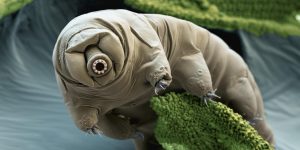The superpowers of Tardigrades
The Answer: Tardigrades are chunky, microscopic aquatic creatures that look liked naked mole rats, and they may be the key to understanding how we can tolerate radiation

(BBC, 2015)
“Everyone should know this stuff” level
How would our world be different if we were able to live through exposure to “extreme conditions”? We could explore space, volcanoes, and the depths of the sea, with no risk to our lives. Tardigrades, commonly known as water bears, live in this fantasy world. They are microscopic adorable organisms, found both on land and in water, that have some incredible abilities (Miller, 2011). They are the size of the tip of a pencil and semi-transparent. Their bodily systems are very similar to those of larger organisms, with a complex digestive and nervous system (Miller, 2011). They have the peculiar (but awesome) ability to survive in extreme conditions. They are tolerant to high levels of radiation, can survive years of dehydration, and have been released into the vacuum of space for an extended amount of time (Feltman, 2016). They have three states of existence that allow them to do this: active, anoxybiosis and crytobiosis. In their active state they exist as any other animal. The anoxybiosis state occurs when they cannot get enough oxygen. They inflate until their environment becomes more arid and they can become active. Cryptobiosis occurs when their metabolism stops. They essentially die and then come back to life. They reduce to a third of their size and lose almost of the water in their body. In this state, tardigrades can live no matter what the environment. (Miller, 2011).
Though scientists have known about the extraordinary abilities of these organisms for decades, we have never understood quite how they are able to do what they do. In an interesting twist, scientists from the University of Tokyo may have found the protein that is unique to these creatures that allows them to survive deadly conditions. The protein is completely unique to tardigrades, but it may also have the ability to protect human cells from radiation if manipulated correctly (Feltman, 2016). The genome resistant to radiation was found within the species Ramazzottius varieornatus. Within this genome is a protein known as Dsup (Damage Suppressor), and it is the key to protecting tardigrade’s DNA (University of Tokyo, 2016). To test the human cells, scientists first exposed regular human cells to radiation. The DNA in the cells was, as expected, harmed. The scientists then altered separate human cells so that they would produce Dsup. The cells ended up experiencing 40% less harm from radiation than the human cells (Feltman, 2016) (University of Tokyo, 2016). The scientists also noted that the human cells that could produce Dsup could continue to reproduce after they were exposed to the radiation (University of Tokyo, 2016). Takuma Hashimoto, one of the head scientists, said, “What’s astonishing is that, previously, molecules that repair damaged DNA were thought to be important for tolerating radiation. On the contrary, Dsup works to minimize the harm inflicted on the DNA.” (University of Tokyo, 2016)
For geniuses only level
Due to the fact that DNA is usually harmed with exposure to radiation, scientists came to the conclusion that the protein that protects tardigrades from radiation would be connected with their DNA. (Hashimoto, 2016). To figure out which protein it was, “the scientists took the protein component out of the chromatin and broke it into pieces. They then took the pieces and ran them through a mass spectrometer, which sends the pieces through a matrix and separates them by size and charge. They isolated the pieces of protein and derived the peptide sequences. They were able to determine which protein was resistant to radiation. (Personal correspondence: Dr. Selena Gell) (Personal correspondence: Amanda Giuliani).” They identified the protein as Dsup. Dsup-expressing cells and regular cells were exposed to 10 Gy X-ray radiation and the results were recorded (Hashimoto, 2016). “The amount of radiation damage was measured by how fragmented the DNA was. (Personal correspondence: Dr. Selena Gell)” The DNA saw 40% less damage in the Dsup cells (Hashimoto, 2016). To prove that Dsup allowed human cells to reproduce after radiation, the scientists tracked the cells. The ones that were affected by radiation were seen still able to reproduce (Feltman, 2016). What does this say for the future how humans are affected by radiation? This is the first step in a long road into discovering how to manipulate human cells in a potentially beneficial way. Takezaku Kinieds said, “It could be helpful for space flight, radiotherapy and radiation workers in the far future.” (Feltman, 2016)
Impress your friends and family with these three related facts:
Fact 1: Tardigrades are also known as water bears.
Fact 2: Tardigrade’s cells do not multiply. Rather, they grow. They are born with adult cells. (Baidya, 2014)
Fact 3: Tardigrades have outlived the dinosaurs. They are more than 530 million years old. (Baidya, 2014)
The Question: What are tardigrades and how are they such durable creatures?

Author: This article was written by Julia DiCostanzo, a senior at Choate Rosemary Hall in Wallingford, CT. Julia’s spirit animal is the teacup pig. Someday, Julia will be famous for living off only cereal for her entire life.
Works Cited:
Baidya, S. (2014, July 14). 20 Interesting Tardigrade Facts. Retrieved from Facts Legend website: http://factslegend.org/ 20-interesting-tardigrade-facts/
Emerging Technology from the arXiv. “The Amazing Trajectories of Life-Bearing Meteorites from Earth.” MIT Technology Review, 11 Apr. 2012, www.technologyreview.com/s/427474/ the-amazing-trajectories-of-life-bearing-meteorites-from-earth/.
Feltman, R. (2016, September 20). Water bears’ latest superpower: Proteins that protect them from radiation. Washington Post. Retrieved from http://link.galegroup.com/apps/doc/A464104138/SCIC?u=wall96493&xid=635655ed
Hashimoto, T. (2016). Extremotolerant tardigrade genome and improved radiotolerance of human cultured cells by tardigrade-unique protein. Nature Communications. Retrieved from http://www.nature.com/articles/ncomms12808
Jönsson1, K. I. (2008, September 9). Tardigrades survive exposure to space in low Earth orbit. Retrieved from ScienceDirect website: http://www.sciencedirect.com/science/article/pii/S0960982208008051
Miller, W. R. (2011). Tardigrades: these ambling, eight-legged microscopic “bears of the moss” are cute, ubiquitous, all but indestructible and a model organism for education. American Scientist, 99(5), 384+. Retrieved from http://link.galegroup.com/apps/doc/A273421032/SCIC?u=wall96493&xid=b3d5672b
Personal correspondence: Dr. Selena Gell
Personal correspondence: Amanda Giuliani
University of Tokyo. (2016, September 20). Demystifying the resilience of water bears: Protein protects human cultured cells from radiation damage. ScienceDaily. Retrieved February 7, 2017 from www.sciencedaily.com/releases/2016/09/160920131045.htm

Leave a Reply